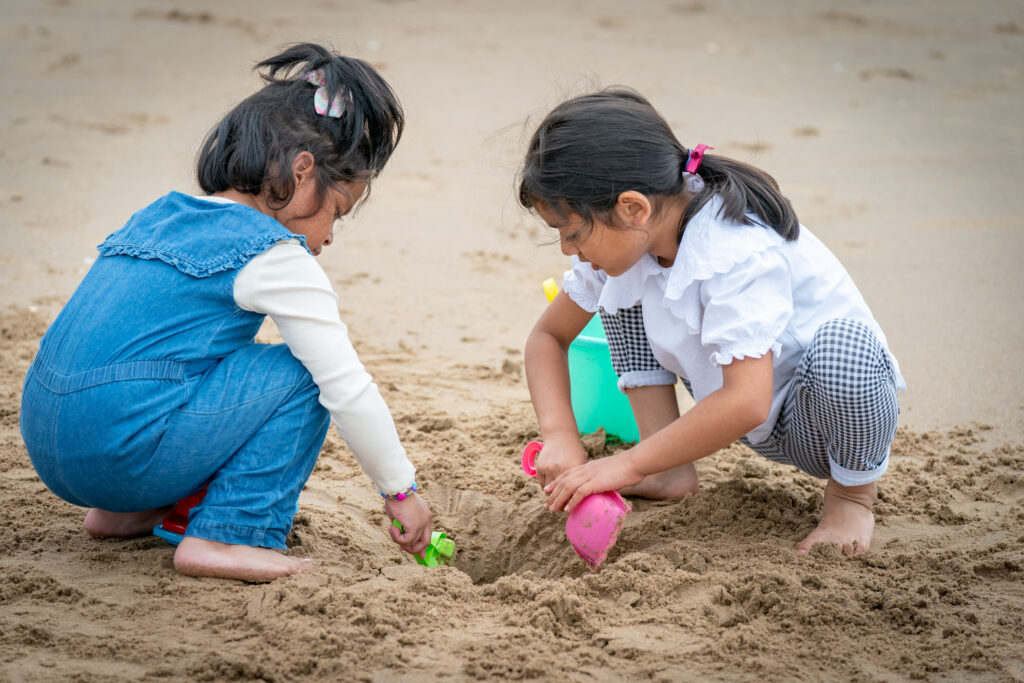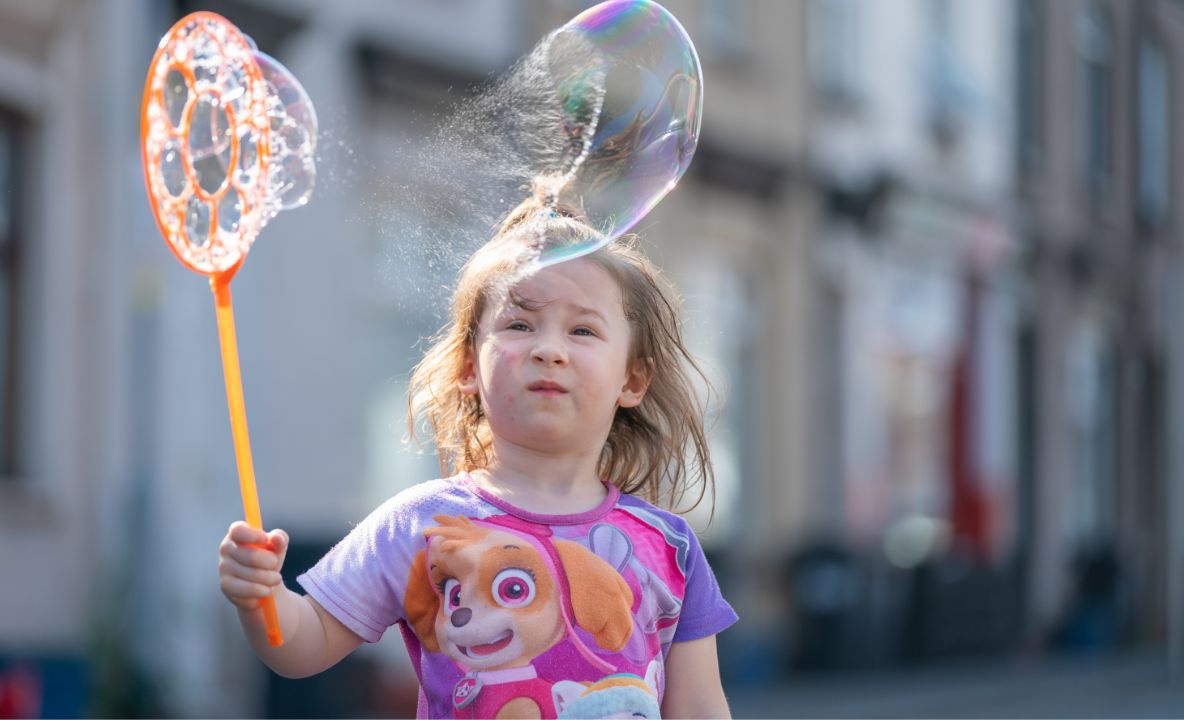Play
Spaces for playing
Children play wherever they are and in all sorts of places, but some spaces have been created with the particular intention of supporting children’s play.

They include dedicated play areas, specifically provided for play, as well as open spaces and natural spaces that are also used for other functions.
Play areas and playgrounds have various manufactured equipment and are used by children of all ages. Open spaces such as parks, football pitches and recreational space are often used for playing and may represent the only outdoor space in a community.
Natural spaces such as woods, beaches, community gardens and rivers also support children’s play. Specialist play equipment isn’t necessarily needed. Water, trees and bushes change with the seasons and children can use them in a variety of ways, getting a lot out of playing with what is there naturally.
All good spaces for playing offer a rich play environment with lots of play value for every child.
What is a rich play environment?
A rich play environment is varied and interesting. According to the Welsh Government’s definition (from Wales – a Play Friendly Country), it’s a place where children:
- can play in their own way
- can make a range of choices
- have many possibilities to create and develop their own play.
In Wales – a Play Friendly Country, the Welsh Government states:
‘A rich play environment is one which is flexible, adaptable, varied and interesting. It maximises the potential for socialising, creativity, resourcefulness, challenge, and choice. It is a trusted public space where children feel free to play in their own way, in their own time, on their own terms.’
The Welsh Government goes on to say that:
‘quality play provision offers all children the opportunity to freely interact with or experience the following:
- Other children – of different ages and abilities with a choice to play alone or with others, to negotiate, co-operate, fall out, and resolve conflict.
- The natural world – weather, trees, plants, insects, animals, mud.
- Loose parts – natural and man-made materials that can be manipulated, moved and adapted, built and demolished.
- The four elements – earth, air, fire and water.
- Challenge and uncertainty – graduated opportunities for risk taking; both on a physical and emotional level.
- Changing identity – role play and dressing up.
- Movement – running, jumping, climbing, balancing, rolling, swinging, siding and spinning.
- Rough and tumble – play fighting.
- The senses – sounds, tastes, textures, smells and sights.’
What is play value?
Play value is what an environment, object or piece of equipment brings to children’s experience of play. A space rich in play value creates opportunities for a variety of physical, social and sensory play experiences. Something will have high play value if children are able to play with it in many different ways, integrate it into their play or use it to develop their own ideas and actions.
What makes the design of a play space successful?
Design for Play is guidance produced by Play England in 2008 and it continues to provide a good start when planning and designing play spaces. This guidance highlights ten principles for designing successful play spaces. Following these principles helps to ensure that the space provides a rich play environment.
Successful play spaces:
- are bespoke – they don’t come straight out of a catalogue and are designed to integrate with their surroundings.
- are well located – they are placed where they have the best chance of being used, close to homes and safe routes for walking and cycling.
- make use of natural elements – they feature trees and bushes, grass, mud, sand, rocks, boulders and landscaping, all of which encourage a range of different types of playing.
- provide a wide range of play experiences – they offer children far greater play value. Play areas with seating, shelter and opportunities to create and run around are more valuable than tightly fenced areas with a few pieces of equipment.
- are accessible to both disabled and non-disabled children – this is not just about providing wheelchair accessibility. Natural elements like sand and mud pits allow children with limited mobility to engage with the natural world and enjoy sensory stimulation. Steep slopes provide an enjoyable challenge for those whose life is spent on flatter ground.
- meet community needs – a play space is seen as a space for the whole community and should be seen as one. Parents and grandparents use the space too, so it’s important the whole community is involved in its development.
- allow children of different ages to play together – children’s lives are often structured into age- groups, especially in school. Younger children learn best about the world from older children. Older children benefit too, experiencing positive feelings of responsibility and empathy when playing with younger children. Intelligent play space design allows children to mix even if certain elements within the space are more appealing to children at particular developmental stages.
- build in opportunities to experience risk and challenge – children learn from experience and taking small risks develops this learning. Opportunities to balance and climb and move around on uneven ground all build children’s skills, abilities and confidence.
- are sustainable and appropriately maintained – whatever the size of the play space, plans need to be in place from the beginning to ensure the space will be maintained and sustained in the future.
- allow for change and evolution – children like to be able to change their environment to keep it fresh and exciting. There are different ways of making this possible: ensuring there are moveable items, including natural element, developing the space over a long period of time so it evolves rather than arriving finished one day and never changing.
Taking care of a play space
Play spaces need a regular programme of maintenance and inspection. The frequency of inspections will vary based on the size of the space, the amount of equipment, and the location and resources available. Inspections can involve:
- Maintenance checks – daily or weekly visual checks along with the removal of litter and debris.
- Routine operational inspections – about every three months to test working parts and equipment.
- Annual technical inspections – recommended by both the Royal Society for the Prevention of Accidents (RoSPA) and the Health and Safety Executive (HSE), these technical inspections are carried out once a year by a professionally competent independent playground inspector.
Contact the Register of Play Inspectors International (RPII) for a list of inspectors working in Wales.
Wales’ commitment to smokefree playgrounds and play settings
Wales is the first country in the UK to make it illegal to smoke in playgrounds, school grounds and outdoor care settings for children.
The law came into force on 1 March 2021. Playgrounds in Wales must be smoke-free, and so must school grounds, outdoor day care and childminding settings.
Guidance from the Welsh Government sets out what those responsible for the smoke-free settings need to do. For example, the manager or person responsible for the setting must take reasonable steps to stop anyone who is smoking there.
‘No Smoking’ signs must be displayed in playgrounds and school grounds. Signs do not have to be displayed in outdoor care settings, however. The Welsh Government has made suitable signs available and you can find out more online.
Resources
Developing and managing play spaces
This toolkit aims to support community councils and community groups who are interested in developing and managing play spaces. It contains useful information and tools to use when engaging with children and communities.
Creating accessible play spaces
This toolkit is designed to provide information that will help with the creation of spaces where all children can play. It aims to support those developing and upgrading accessible play spaces.
Planning your play area
Our Playful Childhoods website aims to support local groups in creating and maintaining play friendly neighbourhoods in their areas. The ‘Planning your play area’ section includes practical ideas to help communities plan their own play spaces.

